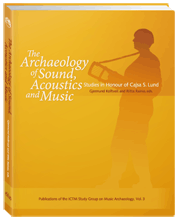Sound Archaeology and the Soundscape
Rupert Till
This paper begins with a discussion of the bone pipe or flute found in Hohle Fels Cave in Germany, exploring performance on reconstructed replica instruments and the relevance of the
acoustics of the site. Thee paper examines a sound archaeology project exploring sound in caves in northern Spain that feature Palaeolithic visual motifs, and the use of digital film, museum exhibits and interactive apps to disseminate the research and democratise its interpretation and reception.
This research reveals problems that emerge from the use of the term music in association with sound in the distant past. This is discussed in the context of the effect of the emergence of the field of sound studies on music archaeology, and it is suggested that archaeoacoustics and music archaeology are subsets of a parent field of sound archaeology, which is itself a sub-field of sound studies.
The study traces the beginning of these developments to the work of Cajsa S. Lund, who widened the field of music archaeology from a focus on musical instruments to include sound tools and soundscapes. It concludes that greater engagement with the wider field of sound studies would have a positive impact on music archaeology, archaeoacoustics and sound archaeology.




